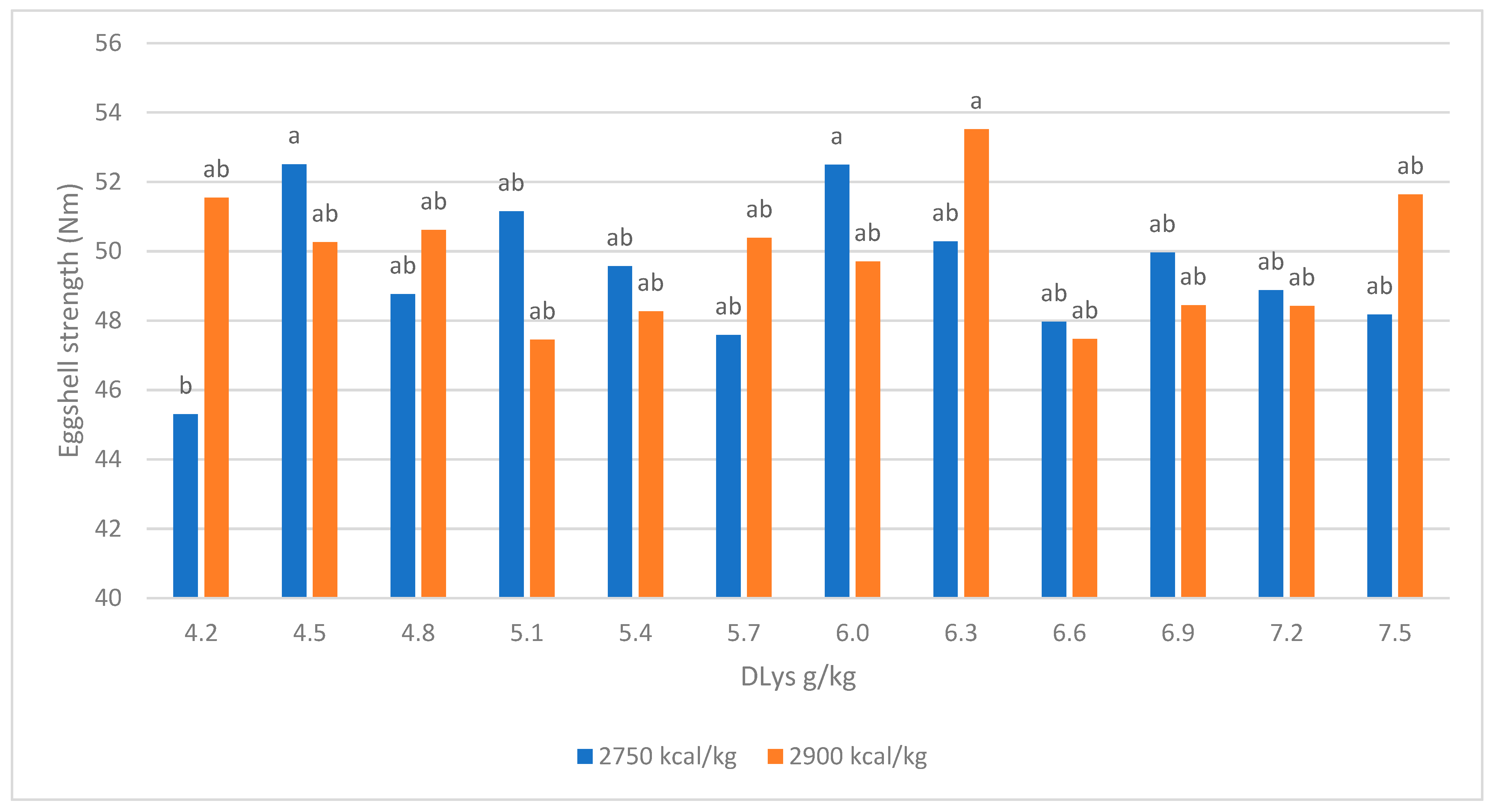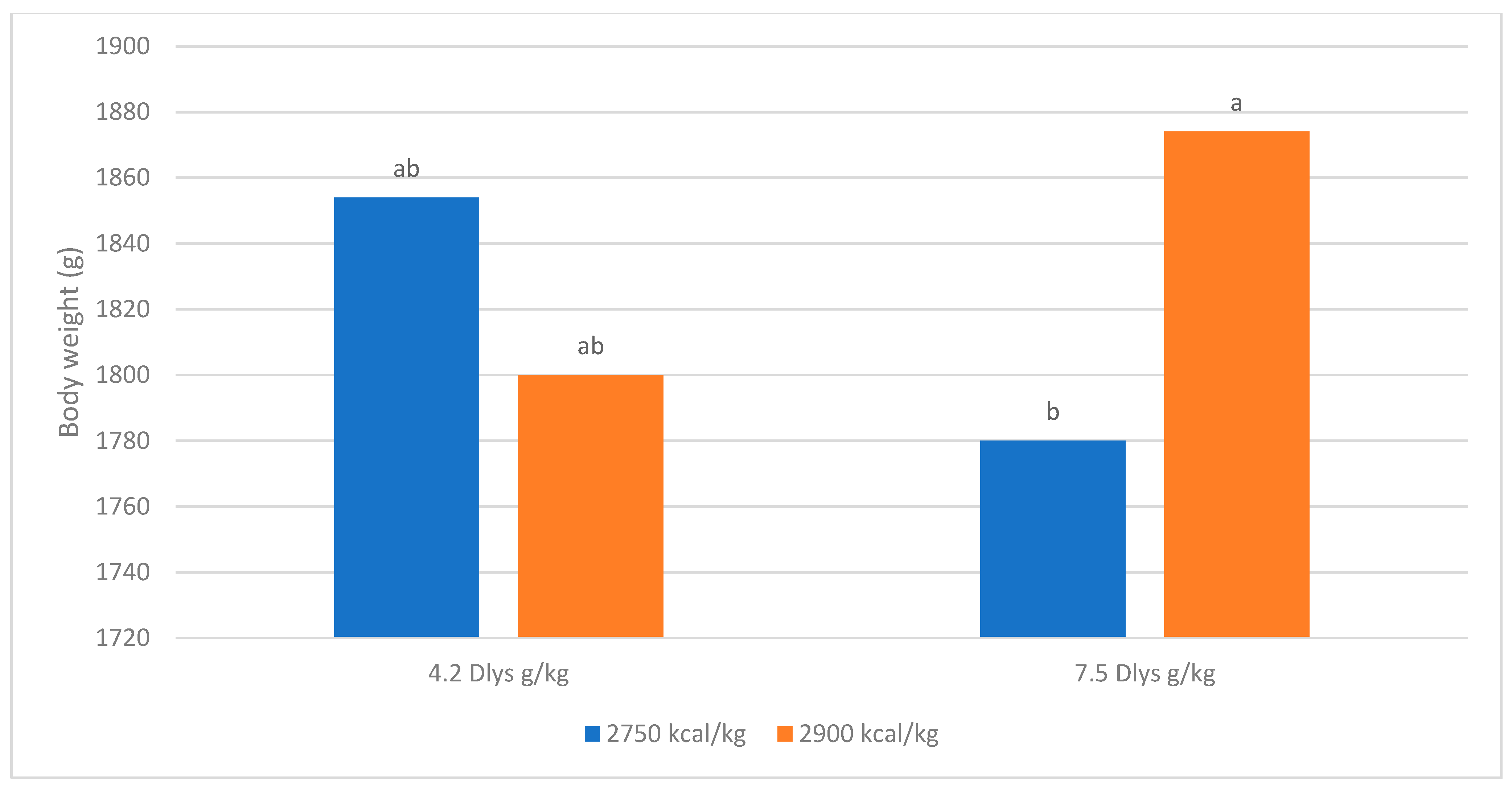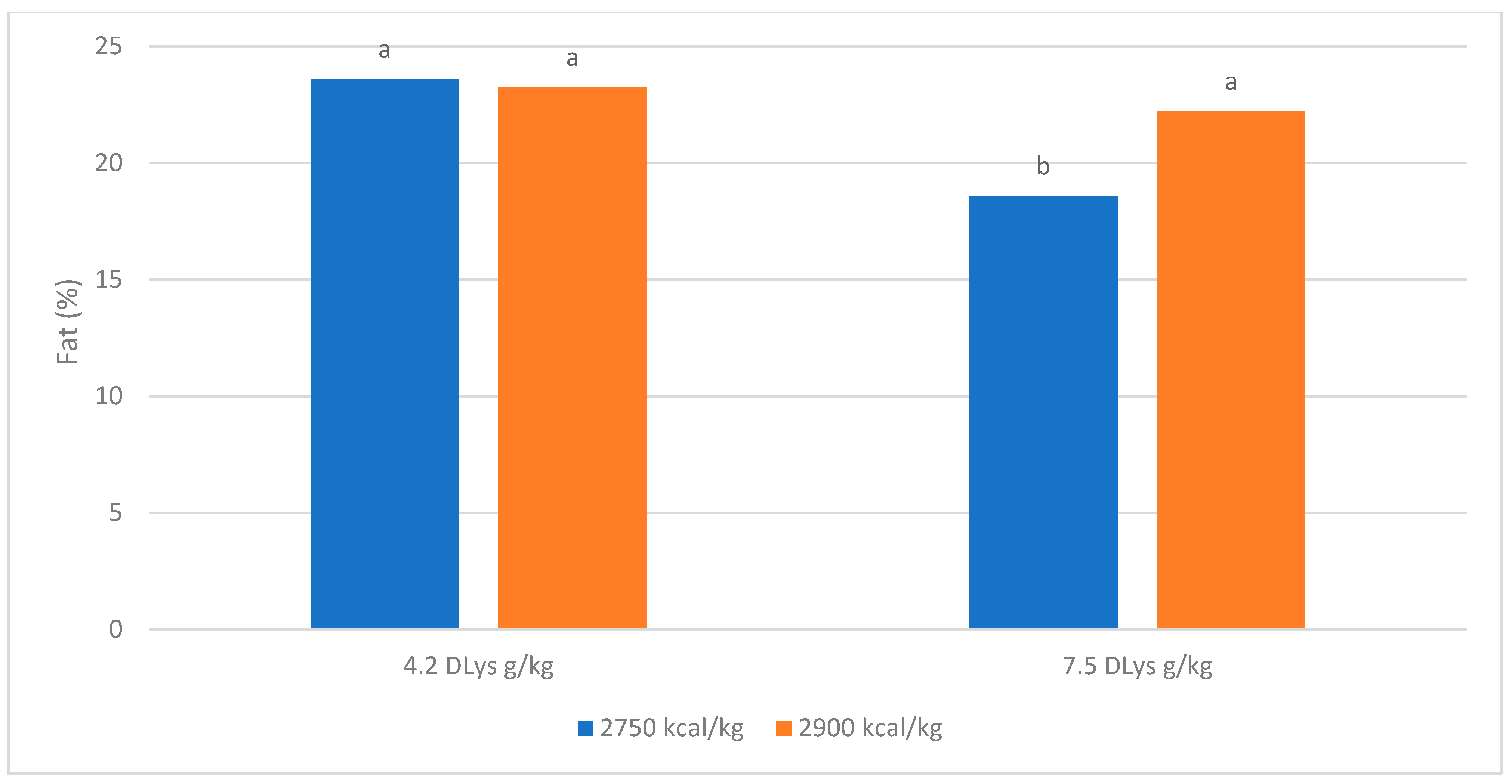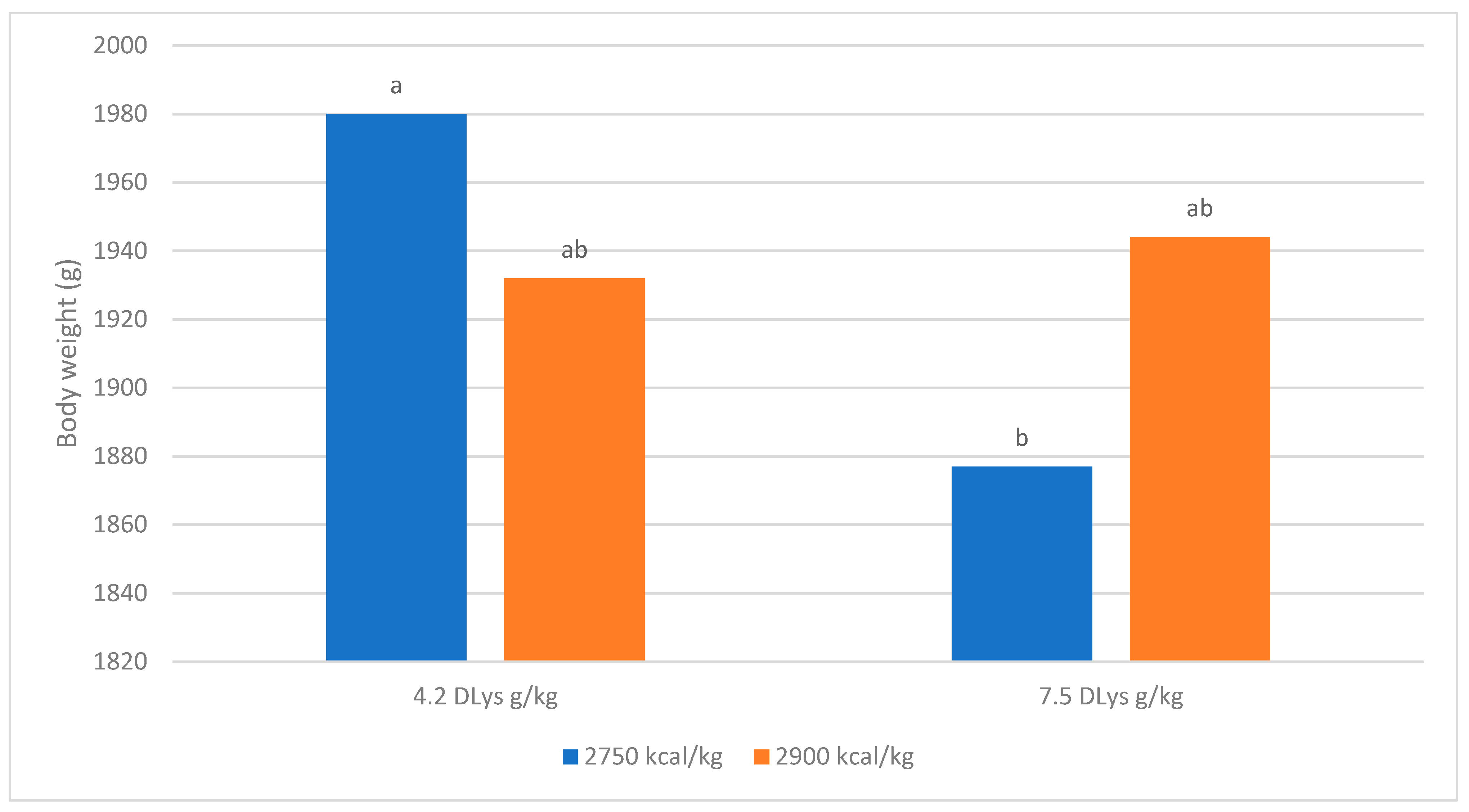Influence of Dietary Energy and Lysine Concentration on Layer Hen Performance and Egg Quality During Peak Production
Abstract
1. Introduction
2. Materials and Methods
2.1. Husbandry, Diets, and Experimental Design
2.2. Experimental Design and Diets
2.3. Feed Intake, Body Weight and Egg Production
2.4. Egg Quality
2.5. Carcass and Liver Composition
2.6. Statistical Analysis
3. Results
3.1. Interaction Between AMEn and DLys on Production, Egg Quality and Carcass and Liver Composition
3.2. Energy Content of the Diet
3.3. Digestible Lysine Content of the Diet
4. Discussion
4.1. Interaction Between AMEn and DLys on Production, Egg Quality and Carcass and Liver Composition
4.2. Energy Content of the Diet
4.3. Digestible Lysine Content of the Diet
5. Conclusions
Author Contributions
Funding
Institutional Review Board Statement
Informed Consent Statement
Data Availability Statement
Acknowledgments
Conflicts of Interest
Abbreviations
| AMEn | Effects of energy |
| DLys | Digestible lysine |
| TEW | Total egg weight |
| AEW | Average egg weight |
| TEN | Total egg number |
| LR | Laying rate |
| TFI | Total feed intake |
| ADFI | Average daily feed intake |
| MORT | Mortality |
| BW | Body weight |
| BWG | Body weight gain |
| EST | Eggshell thickness |
| ESS | Eggshell breaking strength |
| YW | Yolk weight |
| AW | Albumin weight |
| SW | Eggshell weight |
| kg | Kilogram |
| wk | Week |
| EMO | Egg mass output |
| FCR | Feed conversion ratio |
| L | Linear |
| Q | Quadratic |
References
- Bendezu, H.C.P.; Sakomura, N.K.; Venturini, K.S.; Sato, J.; Hauschild, L.; Malheiros, E.B.; Gous, R.M. Response of laying hens to amino acid intake. In Nutritional Modeling for Pigs and Poultry; CABI: Wallingford, UK, 2015; pp. 259–268. ISBN 978-1-78064-412-7. [Google Scholar] [CrossRef]
- Macelline, S.P.; Toghyani, M.; Chrystal, P.V.; Selle, P.H.; Liu, S.Y. Amino acid requirements for laying hens: A comprehensive review. Poult. Sci. 2021, 100, 101036. [Google Scholar] [CrossRef] [PubMed]
- Sell, J.L.; Angel, C.R.; Escribano, F. Influence of supplemental fat on weights of eggs and yolks during early egg production. Poult. Sci. 1987, 66, 1807–1812. [Google Scholar] [CrossRef] [PubMed]
- Leeson, S.; Summers, J.D.; Caston, L.J. Response of layers to low nutrient density diets. J. Appl. Poult. Res. 2001, 10, 46–52. [Google Scholar] [CrossRef]
- Valkonen, E.; Venalainen, E.; Rossow, L.; Valaja, J. Effects of dietary energy content on the performance of laying hens in furnished and conventional cages. Poult. Sci. 2008, 87, 844–852. [Google Scholar] [CrossRef] [PubMed]
- Ding, Y.; Bu, Z.; Zhang, N.; Li, L.; Zou, X. Effects of metabolizable energy and crude protein levels on laying performance, egg quality and serum biochemical indices of Fenga-1 layers. Anim. Nutr. 2016, 2, 93–98. [Google Scholar] [CrossRef]
- Perez-Bonilla, A.; Novoa, S.; Garcia, J.; Mohiti-Asli, M.; Frikha, M.; Mateos, G.G. Effects of energy concentration of the diet on production performance and egg quality of brown egg-layer hens differing in initial body weight. Poult. Sci. 2012, 90, 3156–3166. [Google Scholar] [CrossRef]
- Scappaticcio, R.; Garcia, J.; Fondevila, G.; de Juan, A.F.; Camara, L.; Mateos, G.G. Influence of the energy and digestible lysine contents of the diet on performance and egg quality traits of brown-egg laying hens from 19 to 59 weeks of age. Poult. Sci. 2021, 100, 101211. [Google Scholar] [CrossRef]
- Bouyeh, M.; Gevorgian, O.X. Influence of different levels of lysine, methionine and protein on the performance of laying hens after peak. J. Anim. Vet. Adv. 2011, 10, 532–537. [Google Scholar] [CrossRef]
- Hy-Line. Hy-Line Silver-Brown commercial layers. In Management Guide; Hy-Line International: West Des Moines, IA, USA, 2020. [Google Scholar]
- Macelline, S.P.; Toghyani, M.; Crystal, P.V.; de Paula Dorigam, J.C.; Greenhalgh, S.; Selle, P.H.; Liu, S.Y. Essential amino acid recommendations for Isa brown layers during peak and post peak production. Poult. Sci. 2022, 101, 102171. [Google Scholar] [CrossRef]
- Scappaticcio, R.; Camara, L.; Herrera, J.; Mateos, G.G.; de Juan, A.F.; Fondevila, G. Influence of the energy concentration and the standardized ileal digestible lysine content of the diet on performance and egg quality of brown-egg laying hens from 18 to 41 weeks of age. Poult. Sci. 2022, 101, 102197. [Google Scholar] [CrossRef]
- Kakhki, R.A.M.; Alfonso-Carrillo, C.; Garcia-Ruiz, A.I. The impact of digestible lysine and sulphur amino acids on eggshell quality and egg weight control in old ISA brown hens during 62 to 74 wk. Poult. Sci. 2023, 102, 102860. [Google Scholar] [CrossRef]
- CVB (Centraal Veevoederbureau). CVB Table Booklet Feeding of Poultry; CVB-series no 61; Federatie Nederlandse Diervoederketen: Wageningen, The Netherlands, 2018. [Google Scholar]
- Grobas, S.; Mendez, J.; Lazaro, R.; de Blas, C.; Mateos, G.G. Influence of source and percentage of fat added to diet on performance and fatty acid composition of egg yolks of two strains of laying hens. Poult. Sci. 2001, 80, 1171–1179. [Google Scholar] [CrossRef] [PubMed]
- Safaa, H.M.; Serranto, M.P.; Valencia, D.G.; Arbe, X.; Jimenez-Morento, E.; Lazaro, R.; Mateos, G.G. Effects of the levels of methionine, linoleic acid, and added fat in the diet on productive performance and egg quality of brown laying hens in the late phase of production. Poult. Sci. 2008, 87, 1598–1602. [Google Scholar] [CrossRef]
- van Eck, L.; Chen, H.; Carvalhido, I.; Enting, H.; Kwakkel, R. The influence of breed, dietary energy and lysine persistency and body composition of laying hens. Poult. Sci. 2024, 103, 104124. [Google Scholar] [CrossRef] [PubMed]
- Statistical Analysis System. SAS User’s Guide: Statistics Version 9.4; SAS Institute Inc.: Cary, NC, USA, 2022. [Google Scholar]
- Samuals, M.L. Statistics for the Life Sciences; Collier MacMillan Publishers: London, UK, 1989. [Google Scholar]
- Safaa, H.M.; Serrano, M.P.; Valencia, D.G.; Frikha, M.; Jimenez-Moreno, E.; Mateos, G.G. Production performance and egg quality of brown egg -laying hens in the late phase of production as influenced by levels and source of calcium in the diet. Poult. Sci. 2008, 87, 2043–2051. [Google Scholar] [CrossRef]
- Wang, J.; Wang, W.; Qi, G.; Cui, C.; Wu, S.; Zhang, H.; Zu, L.; Wang, J. Effects of dietary Bacillus subtilis supplementation and calcium levels on performance and eggshell quality of laying hens in the late phase of production. Poult. Sci. 2021, 100, 100970. [Google Scholar] [CrossRef]
- Cufadar, Y.; Olgun, O.; Yildiz, A.O. The effect of dietary calcium concentration and particle size on performance, eggshell quality, bone mechanical properties and tibia mineral contents in moulted laying hens. Br. Poult. Sci. 2011, 52, 761–768. [Google Scholar] [CrossRef]
- Wu, G.; Bryant, M.M.; Voitle, R.A.; Roland, D.A. Effect of dietary energy on performance and egg composition of Bovans-White and Dekalb-White hens during phase 1. Poult. Sci. 2005, 84, 1610–1615. [Google Scholar] [CrossRef] [PubMed]
- Wu, G.; Gunawardana, P.; Bryant, M.M.; Voitle, R.A.; Roland, D.A. Effect of dietary energy and protein on performance, egg composition, egg solids, egg quality and profits of Hy-Line W-36 hens during phase 3. J. Poult. Sci. 2007, 44, 52–57. [Google Scholar] [CrossRef]
- Keshavarz, K.; Nakajima, S. The effect of dietary manipulations of energy, protein and fat during the growing and laying periods on early egg weight and egg composition. Poult. Sci. 1995, 74, 50–61. [Google Scholar] [CrossRef]
- Rama Rao, S.V.; Ravindran, V.; Srilatha, T.; Panda, A.K.; Raju, M.V.L.N. Effect of dietary concentrations of energy, crude protein, lysine, and methionine on the performance of white Leghorn layers in the tropics. J. Appl. Poult. Sci. 2011, 20, 528–541. [Google Scholar] [CrossRef]
- Harms, R.H.; Russel, G.B.; Sloan, D.R. Performance of four strains of commercial layers with major changes in dietary energy. J. Appl. Poult. Res. 2000, 9, 535–541. [Google Scholar] [CrossRef]
- Jiang, S.; Cui, L.; Shi, C.; Ke, X.; Luo, J.; Hou, J. Effects of dietary energy and calcium levels on performance, eggshell quality and bone metabolism in hens. Vet. J. 2013, 198, 252–258. [Google Scholar] [CrossRef] [PubMed]
- Han, Y.; Thacker, P. Influence of energy levels and Glycine supplementation on performance, nutrient digestibility and egg quality in laying hens. Asian-Australas. J. Anim. Sci. 2011, 10, 1447–1455. [Google Scholar] [CrossRef]
- Grobas, S.; Mendez, J.; de Blas, C.; Mateos, G.G. Influence of dietary energy, supplemented fat and Linoleic acid concentration on performance of lying hens at two ages. Br. Poult. Sci. 1999, 40, 681–687. [Google Scholar] [CrossRef] [PubMed]
- Novak, C.; Yakout, H.; Scheideler, S. The combined effects of dietary lysine and total sulfur amino acid level on egg production parameters and egg components in Dekalb Delta laying hens. Poult. Sci. 2004, 83, 977–984. Available online: https://www.researchgate.net/publication/8500759 (accessed on 18 January 2025). [CrossRef]
- Han, G.P.; Kim, J.H.; Kim, J.M.; Kil, D.Y. Transcriptomic analysis of the liver in aged laying hens with different eggshell strength. Poult. Sci. 2023, 102, 102217. [Google Scholar] [CrossRef]
- Ray, S.; Swain, P.S.; Amin, R.U.; Nahak, A.K.; Sahoo, S.K.; Rautray, A.K.; Mishra, A. Prolapse in laying hens: Its pathophysiology and management: A review. Indian J. Anim. Prod. Manag. 2013, 29, 17–24. Available online: https://www.researchgate.net/publication/342067734 (accessed on 12 January 2025).
- Liu, Z.; Wu, G.; Bryant, M.M.; Roland, D.A. Influence of added synthetic lysine in low-protein diets with the methionine plus cystine to lysine ratio maintained at 0.75. J. Appl. Poult. Res. 2005, 14, 174–182. [Google Scholar] [CrossRef]
- Van Krimpen, M.M.; Veldkamp, T.; Van Riel, J.W.; Khaksar, V.; Hashemipour, H.; Blok, M.C.; Spek, W. Estimating requirements for apparent faecal and standardized ileal digestible amino acids in laying hens by a meta-analysis approach. Livest. Res. Rep. 2015, 848, 1–72. [Google Scholar]
- Bikker, P.; Verstegen, M.W.; Campbell, R.G.; Kemp, B. Digestible lysine requirements of gilts with high genetic potential for lean gain, in relation to the level of energy intake. J. Anim. Sci. 1994, 72, 1744–1753. [Google Scholar] [CrossRef] [PubMed]
- Kakhki, R.A.M.; Golian, A.; Zarghi, H. Effect of dietary digestible lysine concentration on performance, egg quality, and blood metabolites in laying hens. Appl. Poult. Res. 2016, 25, 506–517. [Google Scholar] [CrossRef]




| 2750 kcal AMEn/kg 1 | 2900 kcal AMEn/kg 1 | |||
|---|---|---|---|---|
| DLys (g/kg) 2 | 4.2 | 7.5 | 4.2 | 7.5 |
| Ingredients | ||||
| Maize (yellow) | 65.8 | 57.65 | 72.16 | 55.98 |
| Soybean meal (47% CP) | 4.00 | 20.17 | 6.54 | 20.68 |
| Limestone | 7.35 | 7.35 | 7.34 | 7.34 |
| Sunflower meal (38% CP) | 5.25 | 4.00 | 4.00 | 4.00 |
| Limestone (grit) | 4.00 | 4.00 | 4.00 | 4.00 |
| Wheat (bran) | 12.00 | 5.00 | 4.00 | 4.00 |
| Soya oil | 0.30 | 0.49 | 0.65 | 2.65 |
| Salt (fine) | 0.24 | 0.26 | 0.26 | 0.27 |
| Monocalcium phosphate | 0.44 | 0.35 | 0.50 | 0.36 |
| Premix 3 | 0.20 | 0.20 | 0.20 | 0.20 |
| Lysine (78%) | 0.09 | 0.06 | 0.05 | 0.06 |
| Methionine (99%) | 0.05 | 0.25 | 0.05 | 0.25 |
| Sodium bicarbonate | 0.15 | 0.09 | 0.12 | 0.09 |
| Mycotoxin binder 4 | 0.08 | 0.08 | 0.08 | 0.08 |
| Phytase enzyme 5 | 0.03 | 0.03 | 0.03 | 0.03 |
| NSP enzyme 6 | 0.02 | 0.02 | 0.02 | 0.02 |
| Calculated nutrient levels | ||||
| Crude protein (%) | 11.24 | 16.78 | 11.20 | 16.72 |
| AMEn (kcal/kg) 7 | 2750 | 2750 | 2900 | 2900 |
| Ether extract (%) | 3.14 | 3.12 | 3.41 | 5.15 |
| Digestible lysine (g/kg) | 4.20 | 7.50 | 4.20 | 7.50 |
| Analyzed nutrient levels (g/kg) | ||||
| Crude protein (%) | 11.18 | 16.05 | 10.48 | 16.72 |
| Total lysine (g/kg) | 5.00 | 8.20 | 4.30 | 8.60 |
| DLys Intake (mg/d) | Energy Intake (AMEn/d) 4 | Total Egg Numbers | Total Feed Intake (kg) | Total EW (kg) | Egg Mass Output (g) | FCR (g/g) 5 | FCR (g/Dozen) | Body Weight (g) 6 | Body Weight Gain (g) | FCDOZ (ZAR/Dozen) 7 | FCEMO (ZAR/kg) 8 | ADFI (g/d) 9 | Laying Rate (%) | Average EW (g) 10 | |
|---|---|---|---|---|---|---|---|---|---|---|---|---|---|---|---|
| AMEn (kcal/kg) | |||||||||||||||
| 2750 | 719 a | 340 | 105 | 13.86 a | 5.66 a | 47.81 a | 2.46 a | 1.58 a | 2041 | 331 b | 8.04 b | 1.78 b | 123.5 a | 94.00 | 53.70 a |
| 2900 | 686 b | 342 | 105 | 13.27 b | 5.58 b | 46.96 b | 2.40 b | 1.53 b | 2052 | 353 a | 8.32 a | 1.87 a | 118.0 b | 93.08 | 53.34 b |
| DLys (g/kg) | |||||||||||||||
| 4.2 | 529 l | 355 bc | 103 ab | 14.29 bc | 5.25 bd | 43.33 f | 2.72 a | 1.66 a | 2012 | 300 d | 7.89 d | 1.87 | 126.0 ab | 91.25 e | 50.87 g |
| 4.5 | 569 k | 357 bc | 104 ab | 14.16 bc | 5.37 bd | 44.78 ef | 2.63 ac | 1.63 ab | 2014 | 321 cd | 7.91 d | 1.82 | 126.4 ab | 93.03 bcde | 51.59 fg |
| 4.8 | 609 j | 358 bc | 106 a | 14.20 bc | 5.60 bc | 47.52 bd | 2.53 bc | 1.60 ac | 2065 | 356 abc | 7.92 d | 1.81 | 126.8 ab | 94.84 abc | 52.79 e |
| 5.1 | 635 i | 352 bc | 104 ab | 13.95 b | 5.57 bc | 46.67 be | 2.51 b | 1.61 ac | 2084 | 373 ab | 8.11 bcd | 1.78 | 124.5 ab | 93.13 bcde | 53.42 def |
| 5.4 | 663 h | 347 bc | 106 a | 13.74 b | 5.65 abc | 47.91 bc | 2.45 bd | 1.57 bc | 2054 | 355 abc | 8.08 bcd | 1.82 | 122.7 bc | 94.36 abcd | 53.54 cde |
| 5.7 | 674 g | 334 a | 104 ab | 13.34 a | 5.61 bc | 46.80 b | 2.38 df | 1.54 ce | 2067 | 376 a | 8.05 cd | 1.71 | 118.3 d | 92.24 cde | 53.88 bcd |
| 6 | 702 f | 331 a | 104 ab | 13.26 a | 5.57 bc | 46.64 be | 2.45 bd | 1.57 bc | 2053 | 351 abc | 8.37 abc | 1.87 | 117.0 d | 91.46 e | 53.69 bcd |
| 6.3 | 738 e | 331 a | 103 b | 13.11 a | 5.55 bc | 46.33 be | 2.43 bd | 1.56 bcd | 2039 | 344 abc | 8.42 ab | 1.81 | 117.1 d | 92.08 de | 53.76 abcd |
| 6.6 | 783 d | 335 a | 107 a | 13.29 a | 5.81 a | 49.66 ac | 2.29 ef | 1.49 def | 2056 | 335 abcd | 8.19 bcd | 1.84 | 118.7 cd | 95.56 ab | 54.34 abc |
| 6.9 | 811 c | 332 a | 108 a | 13.15 a | 5.86 a | 50.26 a | 2.24 e | 1.47 f | 2039 | 331 bcd | 8.20 bcd | 1.80 | 117.4 d | 95.99 a | 54.51 ab |
| 7.2 | 833 b | 327 a | 107 a | 13.09 a | 5.81 a | 49.60 ac | 2.26 e | 1.48 ef | 2028 | 322 cd | 8.40 abc | 1.78 | 115.6 d | 94.28 abcd | 54.50 ab |
| 7.5 | 882 a | 332 a | 106 a | 13.17 a | 5.79 ac | 49.13 acd | 2.28 ef | 1.50 def | 2046 | 337 abcd | 8.65 a | 1.94 | 117.5 d | 94.31 abcd | 54.88 a |
| SEM 1 | 8.550 | 4.232 | 0.912 | 1.950 | 57.452 | 1.013 | 0.06 | 0.036 | 18.2 | 16.062 | 0.196 | 0.067 | 1.490 | 0.956 | 0.299 |
| p-values | |||||||||||||||
| Main effects 2 | |||||||||||||||
| AMEn | <0.001 | 0.387 | 0.154 | <0.001 | 0.018 | 0.042 | 0.018 | 0.001 | 0.288 | 0.018 | 0.001 | 0.001 | <0.001 | 0.095 | 0.025 |
| DLys | <0.001 | <0.001 | 0.001 | <0.001 | <0.001 | <0.001 | <0.001 | <0.001 | 0.185 | 0.038 | 0.001 | 0.200 | <0.001 | 0.002 | <0.001 |
| Interaction effect | |||||||||||||||
| AMEn × DLys | 0.363 | 0.420 | 0.717 | 0.720 | 0.706 | 0.643 | 0.992 | 0.984 | 0.693 | 0.335 | 0.790 | 0.427 | 0.388 | 0.560 | 0.686 |
| Regression 3 | |||||||||||||||
| Linear | <0.001 | <0.001 | 0.093 | <0.001 | <0.001 | <0.001 | <0.001 | <0.001 | 0.819 | 0.982 | <0.001 | 0.596 | <0.001 | 0.133 | <0.001 |
| Quadratic | <0.001 | <0.001 | 0.248 | <0.001 | <0.01 | <0.01 | <0.001 | <0.001 | 0.097 | 0.025 | <0.01 | 0.183 | <0.001 | 0.337 | <0.001 |
| Eggshell Quality 4 | Egg Components 4 | |||||
|---|---|---|---|---|---|---|
| Eggshell Strength (Nm) | Eggshell Thickness (mm) | Eggshell Weight (g) | Yolk Weight (g) | Albumen Weight (g) | Albumen to Yolk Ratio 5 | |
| AMEn (kcal/kg) | ||||||
| 2750 | 49.39 | 0.45 | 6.63 | 15.74 | 36.12 a | 2.31 |
| 2900 | 49.80 | 0.45 | 6.58 | 15.66 | 35.59 b | 2.29 |
| DLys (g/kg) | ||||||
| 4.2 | 48.43 | 0.46 | 6.33 a | 15.00 a | 33.97 a | 2.28 |
| 4.5 | 51.39 | 0.46 | 6.44 a | 15.10 a | 34.35 ab | 2.29 |
| 4.8 | 46.69 | 0.46 | 6.55 a | 15.72 b | 35.85 cde | 2.30 |
| 5.1 | 49.31 | 0.45 | 6.59 a | 15.79 b | 36.10 cde | 2.30 |
| 5.4 | 48.93 | 0.45 | 6.61 b | 15.97 b | 35.32 bc | 2.23 |
| 5.7 | 48.97 | 0.46 | 6.62 b | 15.68 b | 36.38 cde | 2.33 |
| 6 | 51.09 | 0.45 | 6.64 b | 16.01 b | 35.24 bcd | 2.21 |
| 6.3 | 51.91 | 0.44 | 6.65 b | 15.62 b | 36.92 e | 2.38 |
| 6.6 | 47.73 | 0.46 | 6.65 b | 15.52 b | 36.12 cde | 2.34 |
| 6.9 | 49.17 | 0.45 | 6.70 b | 15.83 b | 36.51 ce | 2.32 |
| 7.2 | 48.63 | 0.44 | 6.71 b | 16.42 c | 36.51 ce | 2.27 |
| 7.5 | 49.91 | 0.46 | 6.76 b | 15.75 b | 36.99 e | 2.36 |
| SEM 1 | 0.993 | 0.005 | 0.059 | 0.185 | 0.454 | 0.04 |
| p-value | ||||||
| Main effects 2 | ||||||
| AMEn | 0.477 | 0.638 | 0.158 | 0.476 | 0.044 | 0.462 |
| DLys | 0.087 | 0.094 | <0.001 | <0.001 | <0.001 | 0.139 |
| Interaction effect | ||||||
| AMEn × DLys | 0.007 | 0.961 | 0.729 | 0.408 | 0.351 | 0.169 |
| Regression 3 | ||||||
| Linear | 0.718 | 0.211 | <0.001 | 0.031 | 0.001 | 0.269 |
| Quadratic | 0.873 | 0.277 | <0.001 | 0.044 | 0.004 | 0.515 |
| Carcass Analysis 3 | Liver Analysis 3 | ||||||||
|---|---|---|---|---|---|---|---|---|---|
| Body Weight (g) | Feather Weight (g) | Moisture (%) | Crude Protein (%) | Fat (%) | Body Weight (g) | Liver Weight (g) | Moisture (%) | Fat (%) | |
| AMEn (kcal/kg) | |||||||||
| 2750 | 1817 | 119 | 55.30 a | 17.44 | 21.08 b | 1928 | 36 | 74.97 | 4.22 b |
| 2900 | 1837 | 117 | 53.15 b | 17.07 | 22.72 a | 1938 | 40 | 73.14 | 7.22 a |
| DLys (g/kg) | |||||||||
| 4.2 | 1828 | 118 | 52.83 b | 16.93 b | 23.41 a | 1956 | 41 a | 72.89 b | 7.04 a |
| 7.5 | 1827 | 118 | 55.62 a | 17.58 a | 20.39 b | 1910 | 35 b | 75.22 a | 4.40 b |
| Adaptation | 1399 | 122 | 6.41 | 18.69 | 14.39 | 1632 | 33 | 73.85 | 4.88 |
| SEM 1 | 14.674 | 4.062 | 0.445 | 0.192 | 0.531 | 16.879 | 1.464 | 0.647 | 0.894 |
| p-value | |||||||||
| Main effects 2 | |||||||||
| AMEn | 0.347 | 0.735 | 0.003 | 0.185 | 0.042 | 0.701 | 0.108 | 0.059 | 0.028 |
| Dlys | 0.989 | 0.967 | <0.001 | 0.029 | 0.001 | 0.071 | 0.014 | 0.019 | 0.050 |
| Interaction effect | |||||||||
| AMEn × DLys | 0.002 | 0.510 | 1.000 | 0.431 | 0.015 | 0.026 | 0.651 | 0.117 | 0.298 |
Disclaimer/Publisher’s Note: The statements, opinions and data contained in all publications are solely those of the individual author(s) and contributor(s) and not of MDPI and/or the editor(s). MDPI and/or the editor(s) disclaim responsibility for any injury to people or property resulting from any ideas, methods, instructions or products referred to in the content. |
© 2025 by the authors. Licensee MDPI, Basel, Switzerland. This article is an open access article distributed under the terms and conditions of the Creative Commons Attribution (CC BY) license (https://creativecommons.org/licenses/by/4.0/).
Share and Cite
Coertze, G.; Kwakkel, R.; Star, L.; Jansen van Rensburg, C. Influence of Dietary Energy and Lysine Concentration on Layer Hen Performance and Egg Quality During Peak Production. Poultry 2025, 4, 26. https://doi.org/10.3390/poultry4020026
Coertze G, Kwakkel R, Star L, Jansen van Rensburg C. Influence of Dietary Energy and Lysine Concentration on Layer Hen Performance and Egg Quality During Peak Production. Poultry. 2025; 4(2):26. https://doi.org/10.3390/poultry4020026
Chicago/Turabian StyleCoertze, Gert, Rene Kwakkel, Laura Star, and Christine Jansen van Rensburg. 2025. "Influence of Dietary Energy and Lysine Concentration on Layer Hen Performance and Egg Quality During Peak Production" Poultry 4, no. 2: 26. https://doi.org/10.3390/poultry4020026
APA StyleCoertze, G., Kwakkel, R., Star, L., & Jansen van Rensburg, C. (2025). Influence of Dietary Energy and Lysine Concentration on Layer Hen Performance and Egg Quality During Peak Production. Poultry, 4(2), 26. https://doi.org/10.3390/poultry4020026






